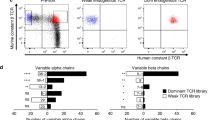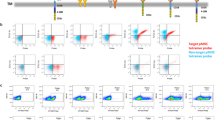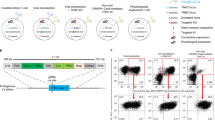Abstract
Genetic modification of T lymphocytes with T-cell receptor (TCR) genes provides a novel tool for adoptive immunotherapy. However, the efficiency of full-length TCR (flTCR)-transduced T cells could be limited by factors such as incorrect pairing between exogenous and endogenous TCR chains and downregulation of the CD3 complex. To overcome these hurdles, one promising strategy is to use three-domain single-chain TCRs (3D-scTCR), in which TCR Vα and Vβ chains are joined by a linker with signal transduction domains fused at the carboxyl termini as signal transducers and amplifiers. Our results showed that surface expression of scTCRs on T cells after retroviral transduction was affected by the origin of the transmembrane (TM) region and placement of signaling domains. scTCR-modified T cells were functional as shown by cytokine (IL-2 and IFN-γ) release in response to antigen stimulation and cytolytic activity against specific target cells. CD8 and CD28, but not the complete CD3 complex, could enhance the scTCR-induced T cell activation. Compared with flTCR-modified T cells and native CTLs, scTCR-modified T cells require higher thresholds of antigen stimulation (∼10−8 M peptide) to be functional. Despite the low efficiency of scTCRs, our data provide insight into further improvements in generating efficient scTCRs for in vivo applications.
This is a preview of subscription content, access via your institution
Access options
Subscribe to this journal
Receive 12 print issues and online access
$259.00 per year
only $21.58 per issue
Buy this article
- Purchase on Springer Link
- Instant access to full article PDF
Prices may be subject to local taxes which are calculated during checkout





Similar content being viewed by others
References
Stancovski I, Schindler DG, Waks T, Yarden Y, Sela M, Eshhar Z . Targeting of T lymphocytes to Neu/HER2-expressing cells using chimeric single chain Fv receptors. J Immunol. 1993;151:6577–6582.
Haynes NM, Snook MB, Trapani JA, et al. Redirecting mouse CTL against colon carcinoma: superior signaling efficacy of single-chain variable domain chimeras containing TCR-zeta vs Fc epsilon RI-gamma. J Immunol. 2001;166:182–187.
Finney HM, Lawson AD, Bebbington CR, Weir AN . Chimeric receptors providing both primary and costimulatory signaling in T cells from a single gene product. J Immunol. 1998;161:2791–2797.
Weijtens ME, Hart EH, Bolhuis RL . Functional balance between T cell chimeric receptor density and tumor associated antigen density: CTL mediated cytolysis and lymphokine production. Gene Therapy. 2000;7:35–42.
Willemsen RA, Weijtens ME, Ronteltap C, et al. Grafting primary human T lymphocytes with cancer-specific chimeric single chain and two chain TCR. Gene Therapy. 2000;7:1369–1377.
Rubinstein MP, Kadima AN, Salem ML, et al. Transfer of TCR genes into mature T cells is accompanied by the maintenance of parental T cell avidity. J Immunol. 2003;170:1209–1217.
Orentas RJ, Roskopf SJ, Nolan GP, Nishimura MI . Retroviral transduction of a T cell receptor specific for an Epstein-Barr virus-encoded peptide. Clin Immunol. 2001;98:220–228.
Clay TM, Custer MC, Sachs J, Hwu P, Rosenberg SA, Nishimura MI . Efficient transfer of a tumor antigen-reactive TCR to human peripheral blood lymphocytes confers anti-tumor reactivity. J Immunol. 1999;163:507–513.
Fujio K, Misaki Y, Setoguchi K, et al. Functional reconstitution of class II MHC-Restricted T cell immunity mediated by retroviral transfer of the alpha beta TCR complex. J Immunol. 2000;165:528–532.
Kessels HWHG, Wolkers MC, van den Boom MD, van der Valk MA, Schumacher TNM . Immunotherapy through TCR gene transfer. Nat Immunol. 2001;2:957–961.
Stanislawski T, Voss RH, Lotz C, et al. Circumventing tolerance to a human MDM2-derived tumor antigen by TCR gene transfer. Nat Immunol. 2001;2:962–970.
Chung S, Wucherpfennig KW, Friedman SM, Hafler DA, Strominger JL . Functional three-domain single-chain T-cell receptors. Proc Natl Acad Sci USA. 1994;91:12654–12658.
Manolios N, Bonifacino JS, Klausner RD . Transmembrane helical interactions and the assembly of the T cell receptor complex. Science. 1990;249:274–277.
John S, Banting GS, Goodfellow PN, Owen MJ . Surface expression of the T cell receptor complex requires charged residues within the alpha chain transmembrane region. Eur J Immunol. 1989;19:335–339.
Bolliger L, Johansson B . Identification and functional characterization of the zeta-chain dimerization motif for TCR surface expression. J Immunol. 1999;163:3867–3876.
Whiteside TL . Signaling defects in T lymphocytes of patients with malignancy. Cancer Immunol Immunother. 1999;48:346–352.
Plaksin D, Polakova K, McPhie P, Margulies DH . A three-domain T cell receptor is biologically active and specifically stains cell surface MHC/peptide complexes. J Immunol. 1997;158:2218–2227.
Schlueter CJ, Schodin BA, Tetin SY, Kranz DM . Specificity and binding properties of a single-chain T cell receptor. J Mol Biol. 1996;256:859–869.
Hoo WF, Lacy MJ, Denzin LK, Voss Jr EW, Hardman KD, Kranz DM . Characterization of a single-chain T-cell receptor expressed in Escherichia coli. Proc Natl Acad Sci USA. 1992;89:4759–4763.
Kieke MC, Sundberg E, Shusta EV, Mariuzza RA, Wittrup KD, Kranz DM . High affinity T cell receptors from yeast display libraries block T cell activation by superantigens. J Mol Biol. 2001;307:1305–1315.
Novotny J, Ganju RK, Smiley ST, et al. A soluble, single-chain T-cell receptor fragment endowed with antigen-combining properties. Proc Natl Acad Sci USA. 1991;88:8646–8650.
Moore MW, Carbone FR, Bevan MJ . Introduction of soluble protein into the class I pathway of antigen processing and presentation. Cell. 1988;54:777–785.
Pogulis RJ, Pease LR . A retroviral vector that directs simultaneous expression of alpha and beta T cell receptor genes. Hum Gene Ther. 1998;9:2299–2304.
Lake DF, Bernstein RM, Schluter SF, Marchalonis JJ . Generation of diverse single-chain proteins using a universal (Gly4-Ser)3 encoding oligonucleotide. Biotechniques. 1995;19:700–702.
Geiger TL, Nguyen P, Leitenberg D, Flavell RA . Integrated src kinase and costimulatory activity enhances signal transduction through single-chain chimeric receptors in T lymphocytes. Blood. 2001;98:2364–2371.
Zhang T, Tsang TC, Harris DT . Efficient transduction of murine primary T cells requires a combination of high viral titer, preferred tropism, and proper timing of transduction. J Hematother Stem Cell Res. 2003;12:123–130.
Lynch CM, Miller AD . Production of high-titer helper virus-free retroviral vectors by cocultivation of packaging cells with different host ranges. J Virol. 1991;65:3887–3890.
Wegener AM, Letourneur F, Hoeveler A, Brocker T, Luton F, Malissen B . The T cell receptor/CD3 complex is composed of at least two autonomous transduction modules. Cell. 1992;68:83–95.
Liao KW, Chou WC, Lo YC, Roffler SR . Design of transgenes for efficient expression of active chimeric proteins on mammalian cells. Biotechnol Bioeng. 2001;73:313–323.
Holler PD, Kranz DM . Quantitative analysis of the contribution of TCR/pepMHC affinity and CD8 to T cell activation. Immunity. 2003;18:255–264.
Van Der Merwe PA, Davis SJ . Molecular interactions mediating T cell antigen recognition. Annu Rev Immunol. 2003;21:659–684.
Haynes NM, Trapani JA, Teng MW, et al. Rejection of syngeneic colon carcinoma by CTLs expressing single-chain antibody receptors codelivering CD28 costimulation. J Immunol. 2002;169:5780–5786.
Moritz D, Wels W, Mattern J, Groner B . Cytotoxic T-lymphocytes with a grafted recognition specificity for Erbb2-expressing tumor-cells. Proc Natl Acad Sci USA. 1994;91:4318–4322.
Zamoyska R . The CD8 coreceptor revisited: one chain good, two chains better. Immunity. 1994;1:243–246.
Roszkowski JJ, Yu DC, Rubinstein MP, Mckee MD, Cole DJ, Nishimura MI . CD8-independent tumor cell recognition is a property of the T cell receptor and not the T cell. J Immunol. 2003;170:2582–2589.
Mallet-Designe VI, Stratmann T, Homann D, Carbone F, Oldstone MB, Teyton L . Detection of low-avidity CD4+ T cells using recombinant artificial APC: following the antiovalbumin immune response. J Immunol. 2003;170:123–131.
Holler PD, Holman PO, Shusta EV, O'Herrin S, Wittrup KD, Kranz DM . In vitro evolution of a T cell receptor with high affinity for peptide/MHC. Proc Natl Acad Sci USA. 2000;97:5387–5392.
Acknowledgements
We thank Debbie Sakiestewa, Dominic Titone and Barb Carolus (Arizona Research Laboratories, Division of Biotechnology, FACS Facility) for FACS support. We thank Drs Dusty A Miller, Larry Pease, Allan M Weissman, James P Allison, Terrence L Geiger, Dan R Littman, Michael Nishimura and Cox Terhorst for providing us with plasmids.
Author information
Authors and Affiliations
Corresponding author
Rights and permissions
About this article
Cite this article
Zhang, T., He, X., Tsang, T. et al. Transgenic TCR expression: comparison of single chain with full-length receptor constructs for T-cell function. Cancer Gene Ther 11, 487–496 (2004). https://doi.org/10.1038/sj.cgt.7700703
Received:
Published:
Issue Date:
DOI: https://doi.org/10.1038/sj.cgt.7700703
Keywords
This article is cited by
-
mRNA as novel technology for passive immunotherapy
Cellular and Molecular Life Sciences (2019)
-
RNA-transfection of γ/δ T cells with a chimeric antigen receptor or an α/β T-cell receptor: a safer alternative to genetically engineered α/β T cells for the immunotherapy of melanoma
BMC Cancer (2017)
-
Single-chain VαVβ T-cell receptors function without mispairing with endogenous TCR chains
Gene Therapy (2012)
-
Rebalancing Immune Specificity and Function in Cancer by T-Cell Receptor Gene Therapy
Archivum Immunologiae et Therapiae Experimentalis (2010)
-
Adoptive T-cell Immunotherapy of Cancer Using Chimeric Antigen Receptor-Grafted T Cells
Archivum Immunologiae et Therapiae Experimentalis (2010)



